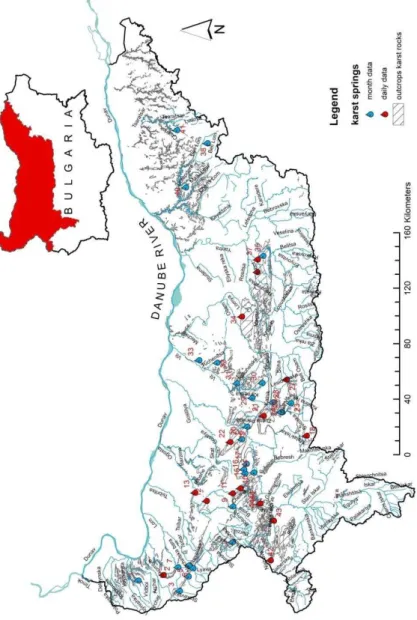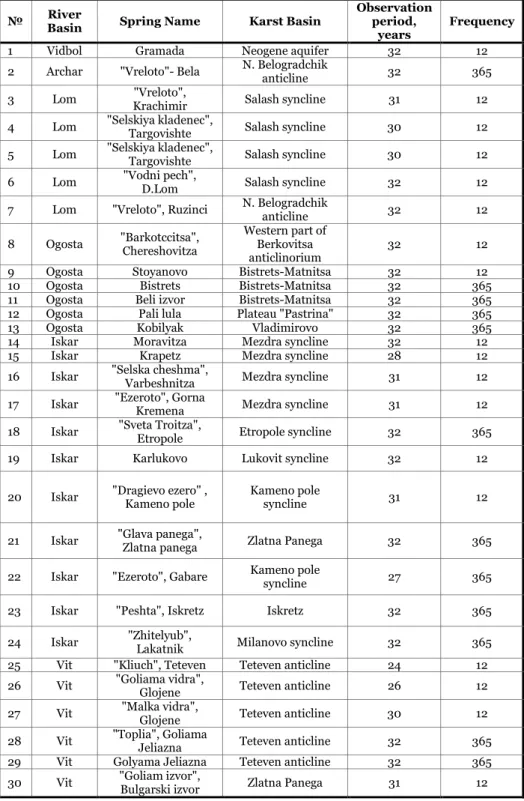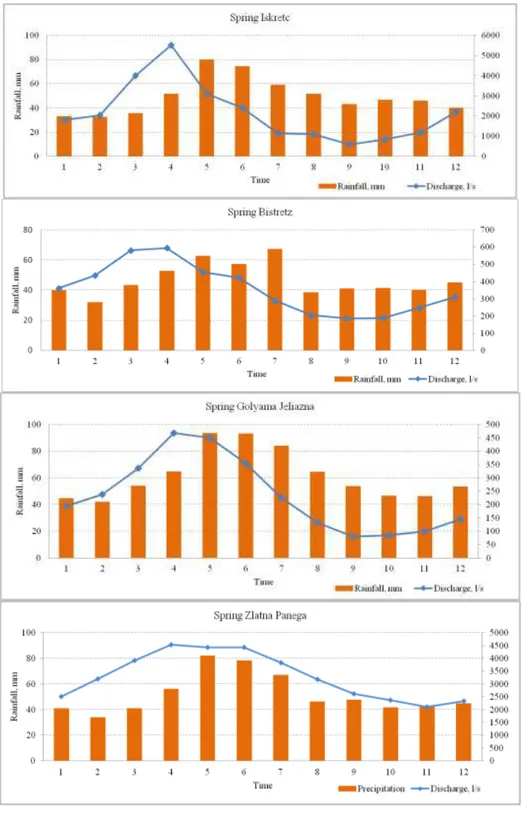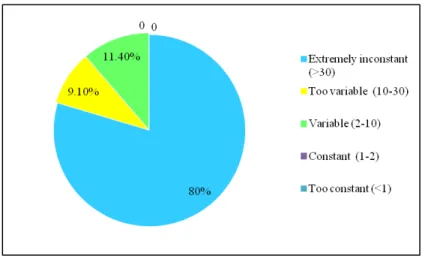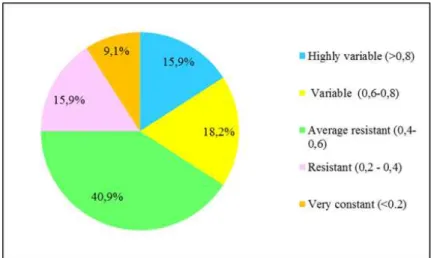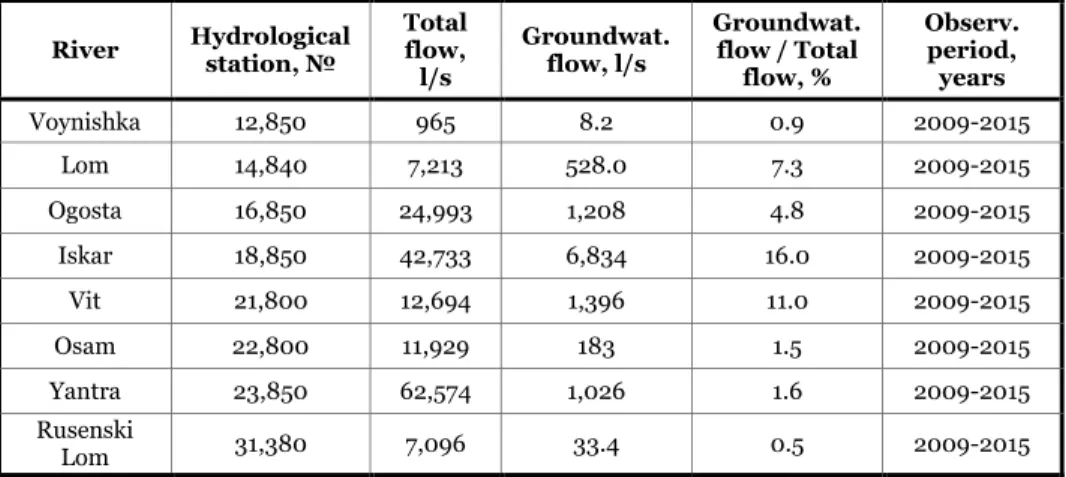Evelina Damyanova1*, Aleksey Benderev**
CHARACTERIZATION OF THE KARST WATER REGIME IN
THE DANUBE CATCHMENT AREA (BULGARIA)
Abstract: The purpose of study is to estimate the role of karst springs in the formation of the flow of the Bulgarian rivers that are right tributaries of the Danube River. The study area includes the region from the Danube River to the main ridge of the Balkan (Stara Planina), representing a major water divide that separates the Black Sea catchment area from the Aegean one. The eastern border represents the watershed between the Danube and the Black Sea hydrological zones. From a geological point of view, the northern part of the area is located on the Moesian platform and the southern part belongs to the Fore Balkan and Balkan areas where various types of rocks of different geologic age outcrop. In some of them, there are conditions for the formation of karst water. In the northern part of the area they form distinct aquifers that gradually sink to the north; this is so called "platform" type of karst. In the southern mountainous part there are numerous karst basins. The most significant of karst springs are included in the national groundwater monitoring network. The hydrographs of karst springs are analyzed in view of the specific features of karstification. To classify the studied springs with respect to their regime, several indicators are used. Furthermore, the role of karst waters in the river runoff of the Bulgarian tributaries of the Danube River is assessed.
Key words: karst, karst water, hydrological regime of karst springs
1 evelina.damyanova@meteo.bg (corresponding author)
*National Institute of Meteorology and Hydrology, Sofia, Bulgaria **Geological Institute – Bulgarian Academy of Sciences, Sofia, Bulgaria
Г АСНИ
С
к
а к
ш а
96 (1), 11-25
BULLETIN
OF THE
S
ERBIAN
G
EOGRAPHICAL
S
OCIETY
2016
---
Original scientific paper UDC 556.34 (282.243.7.044) (437.2) DOI: 10.2298/GSGD1601011D Received: October 12, 2016
Introduction
Groundwaters have an important role in the formation of the river flow. Its contribution is largely dependent on various natural factors. In Bulgaria, due to various physical-geographical, geological and tectonic conditions, different types of groundwater are presented. Widespread karst water is linked both to clearly formed artesian aquifers and mountain karst basins with networks of cavities and galleries. Many karst springs are included in the national monitoring network. The purpose of this study is to summarize the data from the flow regime of the karst springs in the Bulgarian Danube catchment and to assess their role in the formation of the river flow. The results allow us to compare some of the indicators characterizing the regime of springs with view of considering the conditions for the formation of karst waters.
The object of the study is to characterize the main features of the regime of karst springs located in the drainage area of the Danube River. We have chosen 44 karst springs that are included in the National Hydrogeological Network. The study period is 1981-2012. The observation period includes wet, dry, and normal years.
Characteristics of the Studied Area
The study area is the largest area of water management in Bulgaria with a total area of 47,000 km2 (Fig. 1). It includes the catchment areas of all Bulgarian tributaries of the
Danube River. With the exception of the Iskar River, the headwater sources of almost all tributaries are on the ridges and the northern slopes of Stara Planina. Stara Planina (Balkan) is a mountain range with an average altitude of about 900 m and its highest peaks reach over 2,000 m above sea level. The mountain orientation is from the west to the east and divides Bulgaria into two parts: Northern and Southern. The rivers Lom, Ogosta, Vit, and Yantra are the main river courses from the west to the east that collect water from the ridges of the Balkan Mountain. The Danube tributaries originating from the lower parts of the northern slopes and the foothills are with smaller catchments –
these are the rivers Topolovets, Voinishka, Vidbol, Archar, Skomlya, Tsibritsa, Skat, and Rusenski Lom. All Bulgarian tributaries of the Danube River flow northward through the Fore-Balkan area and enter the Danubian Plain. Only the Iskar River has its headwater source in Southern Bulgaria, in the highest mountain on the Balkan Peninsula – Rila, and crosses the Balkan Mountains forming a deep gorge before entering the Danube Plain. The water stage of the Danube River, which is draining the study area, is generally between 35 and 10 m. Digital elevation model for the study area and the catchment characteristics at the river gauge stations are found in the paper by Orehova & Vasileva (2014).
The climatic conditions are important for the formation of surface runoff. The largest part of the drainage area is characterized by temperate climate, and only in the higher parts of the Balkan Mountains the climate is typically mountainous. The mean annual rainfall varies from 400-500 mm to more than 1200-1300 mm, and the average annual air temperature is in the range 10-12ºC in the plain part of the study area.
which determines the availability of different types of groundwater. The conditions of their occurrence are defined especially by the tectonic features. A greater proportion of the area is located within the Moesian platform. It is part of a larger platform structure located in the lower reaches of the Danube River that extends to the northern slopes of the Balkan Mountains and represents a typical artesian basin. It separates several arranged floors of aquifers. In the central and southern part of the artesian basin, as a result of regional faults in the east-west direction, the position of aquifers is block complicated. The southern part of the area, located within the main Balkan Mountains range, is a formed hydrogeological massif of fissure waters in weathering and tectonic cracked zones and drained karst mountain basins, mainly found in the Triassic, Upper Jurassic-Lower Cretaceous carbonate rocks. Karst waters are also widespread within the artesian basin (Antonov & Danchev, 1980). They are attached to the Sarmatian, Upper Cretaceous, Upper Jurassic-Lower Cretaceous aquifers. For the most part they are confined, with the exception of the outcrops in the peripheral parts of the basin where the aquifers are recharged. There are outcrops of karsting carbonate rocks, especially in the southern parts of the artesian basin, which are partially or completely elevated above local erosion basis and can also be treated as separate karst basins (Boyadjiev, 1964; Antonov & Danchev, 1980). Karst basins in the mountain areas and the artesian basins are recharged through rainwater but some of them also receive additional recharge from surface waters. They are drained by springs of different character depending on the specific conditions. These springs are important for the water supply in the surrounding settlements. The most important karst springs that are associated with highly-karstified areas are included in the National Monitoring Network. This entails regular measurements of the flow rates and the temperatures at the observed groundwater monitoring points. Some of these springs have been the subject of earlier studies (Boteva & Raykova, 1968, 1970; Spasov, 1998; Benderev et al., 2014) and their research is taken into consideration.
The National Monitoring Network was established in 1958 and aims to clarify the regime of groundwater in different regions of the country that are characterized by specific hydrological conditions and geological setting (Betsinski, 1958). The data from the observations are published in hydrogeological yearbooks, reference books and are used in different hydrogeological studies and analyses (Orehova & Roussev, 2004). Currently the network includes 446 springs, dug wells, boreholes and artesian wells.
Data Base and Methods
To achieve the goal of this study, some in the water flow regime and its significance for the flow formation of the tributaries of the Danube River are initially established. To elucidate the regime of springs, hydrographs that show the changes in their water flows were drawn. Some of the basic statistical characteristics of the springs are determined –
average, maximum and minimum discharges, median, standard deviation, coefficient of variation. The analysis of the results uses indicators characterizing the change of water amounts of springs.
Tab. 1. Characteristics of the monitored karst springs
№ River Basin Spring Name Karst Basin
Observation period,
years
Frequency
1 Vidbol Gramada Neogene aquifer 32 12
2 Archar "Vreloto"- Bela N. Belogradchik
anticline 32 365
3 Lom "Vreloto",
Krachimir Salash syncline 31 12
4 Lom "Selskiya kladenec", Targovishte Salash syncline 30 12 5 Lom "Selskiya kladenec",
Targovishte Salash syncline 30 12
6 Lom "Vodni pech",
D.Lom Salash syncline 32 12
7 Lom "Vreloto", Ruzinci N. Belogradchik
anticline 32 12
8 Ogosta "Barkotccitsa", Chereshovitza
Western part of Berkovitsa anticlinorium
32 12
9 Ogosta Stoyanovo Bistrets-Matnitsa 32 12
10 Ogosta Bistrets Bistrets-Matnitsa 32 365
11 Ogosta Beli izvor Bistrets-Matnitsa 32 365
12 Ogosta Pali lula Plateau "Pastrina" 32 365
13 Ogosta Kobilyak Vladimirovo 32 365
14 Iskar Moravitza Mezdra syncline 32 12
15 Iskar Krapetz Mezdra syncline 28 12
16 Iskar "Selska cheshma",
Varbeshnitza Mezdra syncline 31 12
17 Iskar "Ezeroto", Gorna
Kremena Mezdra syncline 31 12
18 Iskar "Sveta Troitza",
Etropole Etropole syncline 32 365
19 Iskar Karlukovo Lukovit syncline 32 12
20 Iskar "Dragievo ezero" , Kameno pole
Kameno pole
syncline 31 12
21 Iskar "Glava panega",
Zlatna panega Zlatna Panega 32 365
22 Iskar "Ezeroto", Gabare Kameno pole
syncline 27 365
23 Iskar "Peshta", Iskretz Iskretz 32 365
24 Iskar "Zhitelyub",
Lakatnik Milanovo syncline 32 365
25 Vit "Kliuch", Teteven Teteven anticline 24 12
26 Vit "Goliama vidra",
Glojene Teteven anticline 26 12
27 Vit "Malka vidra",
Glojene Teteven anticline 30 12
28 Vit "Toplia", Goliama
Jeliazna Teteven anticline 32 365
29 Vit Golyama Jeliazna Teteven anticline 32 365
30 Vit "Goliam izvor",
№ River Basin Spring Name Karst Basin
Observation period,
years
Frequency
31 Vit "Batovo ezero",
Dermantzi Lukovit anticline 31 12
32 Vit "Baliovo ezero",
Ugarchin Lukovit anticline 28 12
33 Vit "Selski dol", Barkach Lom-Pleven depression 28 12 34 Vit "Bakalia", Pleven Lom-Pleven
depression 31 12
35 Vit "Ezero", Riben Lom-Pleven
depression 28 12
36 Osam "Maarata", Krushuna Lovetch-Tarnovo 32 365
37 Yantra "Glavata",
Beliakovetz Lovetch-Tarnovo 32 12
38 Yantra "Peshterata",
Musina Lovetch-Tarnovo 32 365
39 Yantra "Bohot", Hotnitza Lovetch-Tarnovo 29 365
40 Rusenski lom
"Poroishte", Poroishte
Baremian-Aptian
aquifer 28 12
41 Rusenski lom
"Poroishte", Poroishte
Baremian-Aptian
aquifer 28 12
42 Rusenski lom
"Varovichetz", Pisanetz
Baremian-Aptian
aquifer 31 12
43 Chairlak "Voden" Baremian-Aptian
aquifer 32 12
44 Nishava "Vreloto", Berende
izvor Nishava 32 365
The obtained results are used to determine the maximum, the minimum, and the average flows. They are distributed according to the stability of the water regime. One of the oldest numerical indicators used is the indicator of Ovchinnikov (1955) representing the ratio Qmax/Qmin, in which the springs are divided into 5 categories. An assessment
according to Gigineyshvili (1979) is also made – it represents the annual internal oscillation of the flow of karst springs (Cv %) showed by the standard deviation of the
monthly average from the average annual flow. The indicator of Panayotov (1983) is also used – it characterizes the center of internal annual distribution of runoff гσд
and represents the standard deviation from its centers in different hydrological years. The similarities and differences of the regimes of the observed karst springs are explored. The role of karst springs in the flow formation in the Bulgarian tributaries is assessed.
Results and Discussion
Relatively more stable flow rates are observed in the springs in areas with a substantial saturated zone and with permanent additional river recharge, e.g. Kobilyak spring (number 13 in Tab. 1) (Fig. 3).
Fig. 2. Change in the water amount of the Zhitelyub spring in a dry and a wet year
Fig. 3. Change in the water amount of the Kobilyak spring in a dry and a wet year
To characterize the changes in the discharge values of the springs, we assessed them by several indicators and the relevant classifications for them (Tab. 2).
Tab. 2. Indicators’ characterizing the flow regime of the monitored karst springs (The colors are taken from Fig. 5-7)
№ Spring name Ql/s min, Ql/s max, Ovchinnikov Qmax/Qmin Gigeyneshvili Cv, % Panayotov σз
1 Gramada 2.2 71.5 32.5 71 0.25
2 "Vreloto"- Bela 1 538 538 52 0.51
3 "Vreloto",
Krachimir 9 1,316 146.2 121 0.48
4
"Selskiya kladenec", Targovishte
10 234 23.4 21 0.51
5
"Selskiya kladenec", Targovishte
0.2 75 375 54 1.33
6 "Vodni pech",
Dolni Lom 5 702 140.4 38 0.96
7 "Vreloto", Ruzinci 1.18 75 63.6 40 1.54
8 "Barkotccitsa" 4.5 32.5 7.2 22 0.12
9 Stoyanovo 2 949 474.5 26 0.43
10 Bistrets 2 4,142 2,071 35 0.38
11 Beli izvor 0 1,450 ∞ 46 0.60
12 Pali lula 8 2,465 308.1 25 0.58
13 Kobiliak 48 1,677 34.9 32 0.30
14 Moravitza 0.17 49.6 291.8 61 0.84
15 Krapetz 30 650 21.7 42 0.68
16 "Selska cheshma",
Varbeshnitza 0.8 36 45 38 0.58
17 "Ezeroto", Gorna
Kremena 1.7 437 257.1 90 0.90
18 "Sveta Troitza",
Etropole 0 574 ∞ 47 0.92
19 Karlukovo 2.4 116 47.9 27 0.32
20 "Dragievo ezero" ,
Kameno pole 15.7 736 46.9 58 0.47
21 "Glava panega",
Zlatna panega 780 27,000 34.6 18 0.49
22 "Ezeroto", Gabare 1 1,489 1,489 61 0.62
№ Spring name Qmin, l/s
Qmax, l/s
Qmax/Qmin Ovchinnikov
Cv, % Gigeyneshvili
σз
Panayotov
24 "Zhitelyub", Lakatnik 11 16,600 1,509 39 0.81
25 "Kliuch", Teteven 0.12 13 108.3 63 0.26
26 "Goliama vidra",
Glojene 45 178 4 14 0.10
27 "Malka vidra",
Glojene 0.8 50 62.5 59 0.25
28 "Toplia", Goliama
Jeliazna 0 11,070 ∞ 54 0.59
29 Karst spring,
Goliama Jeliazna 0 2,400 ∞ 39 0.68
30 "Goliam izvor", Bulgarski izvor 36 524 14.6 40 0.45
31 "Batovo ezero", Dermantzi 1 311 311 66 0.44
32 "Baliovo ezero",
Ugarchin 1 40 40 43 0.73
33 "Selski dol",
Barkach 3.1 40 12.9 24 0.58
34 "Bakalia", Pleven 1 7 7 28 0.32
35 "Ezero", Riben 4 136 34 74 0.52
36 "Maarata",
Krushuna 3 9,300 3,100 83 0.67
37 "Glavata",
Beliakovetz 2.3 327 142.2 55 0.43
38 "Peshterata",
Musina 25 10,000 400 68 0.46
39 "Bohot", Hotnitza 1 12,700 12,700 70 0.46
40 "Poroishte" 0.19 9.17 48.3 37 0.56
41 "Poroishte" 0.09 4.76 52.9 55 0.46
42 "Varovichetz",
Pisanetz 17.5 38 2.2 16 0.04
43 "Voden" 30 172 5.7 36 0.18
44 "Vreloto", Berende
izvor 4 1,838 459.5 50 0.74
Fig. 5. Distribution of springs according to the indicator of Ovchinnikov (1953)
The indicator of Gigineyshvili (1979) gives a better idea of the nature of the inter-annual variation of water rates of the springs (Fig. 6). It represents the relative standard deviation of the average monthly water discharge from the average annual flow. Even better results are obtained when comparing this indicator for a particular spring with a Standard River in the same area. According to this indication, in the observed area there are predominantly springs with preserved zonal character and as a result, the regime of the respective spring is largely similar to the regime of the river flow in the area. Only one spring is characterized by not sustainable regime. A stable regime is observed in the karst springs that are draining the pronounced aquifers in the northern part of the region and springs from the karst mountain basins in which there are a substantial saturated zone or an important role is played by constantly recharging rivers.
The indicator of Panayotov characterizes the intra-annual distribution of the flow of karst springs (Fig. 7). Most of the studied springs are with average resistant intra-annual distribution. To a large extent, there is an overlap of the springs that belong to the resistant group. What is more, there is a considerable overlap between the type of springs that fall into the group of very constant springs according to the indicator of Panayotov and those classified as very resistant according to the indicator of Gigineyshvili. The group with highly variable flow comprises mainly of springs that are draining typical karst mountain basins and have a well-developed channel-gallery network. Regardless of the existence of certain repetitions, there is no correlation between the two indicators (Fig. 8). However, there is a slight tendency for the increase of the values in one indicator to result in the increase of the values in the other. Probably a closer relationship could be established if the springs are divided into different groups depending on the type of karst.
Fig. 7. Distribution of the springs according to the indicator of Panayotov (1983)
The discharge of the studied karst springs is part of the runoff of the respective tributary of the Danube River. The groundwater flow formed by them for the period 2009-2015 is 11,217 l/s (11.2 m3/s) or only 6.59% of the total flow towards the Danube
River for the same period (the used data is from the NIMH hydrological network stations for quantitative monitoring of surface waters located at the mouths of rivers). Their role is different for individual rivers according the involvement of rocks and nature of karstification (Tab. 3).
Tab. 3. Ratio between the groundwater flow and surface water flows
River Hydrological stationз №
Total flow, l/s
Groundwat. flow, l/s
Groundwat. flow / Total
flow, %
Observ. period, years
Voynishka 12,850 965 8.2 0.9 2009-2015
Lom 14,840 7,213 528.0 7.3 2009-2015
Ogosta 16,850 24,993 1,208 4.8 2009-2015
Iskar 18,850 42,733 6,834 16.0 2009-2015
Vit 21,800 12,694 1,396 11.0 2009-2015
Osam 22,800 11,929 183 1.5 2009-2015
Yantra 23,850 62,574 1,026 1.6 2009-2015
Rusenski
Lom 31,380 7,096 33.4 0.5 2009-2015
Even though the National Network includes most of the major karst springs in Bulgaria, the available values do not characterize the amount of karst water involved in the formation of the total river flow. It is quite probable that the role of karst waters in the river runoff is more prominent, especially for the rivers Iskar, Vit and Osam. Here the karst is widespread. These rivers basins there are many other karst springs which are not included in the monitoring network.
Conclusion
Karst springs are characterized by well-expressed seasonality of their discharge. In this study, the flow regime of the major karst springs from the Danube hydrological zone is analyzed based on several indicators (Ovchinnikov, Gigineyshvili and Panayotov). The data are from the National Hydrogeological Network, and the reference period is 1981-2012. The springs are classified according to degree of their variability and therefore their resistivity to droughts. Our results somewhere confirm results to previous authors, but show very clear and in details real changes in the regime of the springs. Ovchinnikov indicator gives a very rough assessment. We think it is better to use both parameters by Panayotov and Gigineyshvili.
This value varies for different Bulgarian rivers and is maximal for the Iskar River (16%). The most significant is the role of the observed karst springs in the watershed of the river Iskar. It is shown in Tab. 3. If we use the springs which are not included in the National Monitoring Network, whose average flow rate is about 1,500-2,000 l/s, this ratio will be higher about 20%. This demonstrates the essential role of the karst water for the formation of runoff, although the area of outcrops of karst rocks in the watershed is fewer than 12%. These rocks are basically in the middle reaches of the river where it crosses the Stara Planina and Fore and they formed a mountain karst. The variability of spring flows is related mainly to the degree of karstification of limestone or marbles and specific features of the recharge of karst basins. The amount and temporal distribution of the precipitation and snowmelt according with the amount of additional recharge from surface water are important in this respect. The same conclusion was obtained and in the
part of Stara planina belonging to Serbia гĐurović б Živkovićз нлмод.
The preliminary conclusions concerning the karst springs presented here are the beginning of an in-depth study of their regime and specific features. Further statistical processing of the data base about the flow rates and their relations to various factors could help in solving a number of problems related to both the water management and clarification of the basic principles for the formation of the flow of these springs in relation to the impact of natural and anthropogenic factors, including climate issues.
References
Antonov, H. & Danchev, D. (1980). Ground waters in Bulgaria. Sofia, Tehnika (in Bulgarian). Benderev A., Aleksiev, I. & Machkova, M. (2014). Hydrogeological setting and regime of the karst
spring at the village Krachimir, West Balkan. Proc. Balkan Speleological Conference–"Sofia’ 2014", 28-30 March 2014 (in Bulgarian).
Betzinski, P. (1958). On the issue of construction of hydrogeological network in NR Bulgaria. Structures and tasks of the network. –Bull. Inst. of Meteorology and Hydrology, 5, 14–18, (in Bulgarian).
Boteva, K. & Raykova, Bl. (1968). On the regime of Isktretz karst spring. Bulgarian Journal of Meteorology and Hydrology, 6, 35-43 (in Bulgarian).
Boteva, K. & Raykova, Bl. (1970). On the regime of large karst springs in the upper reaches of the river Vit. Bulgarian Journal of Meteorology and Hydrology, 3, 27-38 (in Bulgarian).
Boyadjiev, N. (1964). The karst basins in Bulgaria and their subterraneous waters. Bulgarian Journal of Meteorology and Hydrology, 2, 45–96 (in Bulgarian).
Đurovićз P. б Živkovićз њ. гнлмод. љorphological and hydrological characteristics of the Serbian border zone towards Bulgaria. Bulletin of the Serbian Geographical Society, 93(4), 51-88. Gigineyshvili, G. (1979). Karst waters Greater Caucasus and the main problems of karst hydrology,
Tbilisi, Metsniereba (in Russian).
Orehova, T. & Roussev, R. (2004). Overview of national hydrogeological network of Bulgaria.
BALWOIS - Conference on Water Observation and Information System for Decision Support, 25-29 May 2004, Ohrid, FY Republic of Macedonia.
Orehova, T. & Vasileva, T. (2014). Evaluation of the atmospheric chloride deposition in the Danube hydrological zone of Bulgaria, Environmental Earth Sciences, 72(4), 1143-1154.
Ovchinnikov, A. M. (1955). General hydrogeology, Nedra (in Russian).
Panayotov, T. (1983). Classification of karst springs of the reaction to drain their regime. Collection materials, EPSK, 327-333 (in Bulgarian).
Spassov, V. (1998). Evidence of river recharge to the karst spring "Kalna matnitza" (District Vratza).
Evelina Damyanova2*, Aleksey Benderev**
Ј
( )
е мех з
Б .
Б гС дз
ђ ђ .
ђ . С
з з
з . У
. з
з з
. К
мфум-нлмн.
. У
з сзсаз нллф-нлмрз мса .
2 evelina.damyanova@meteo.bg г д
е з С з Б
